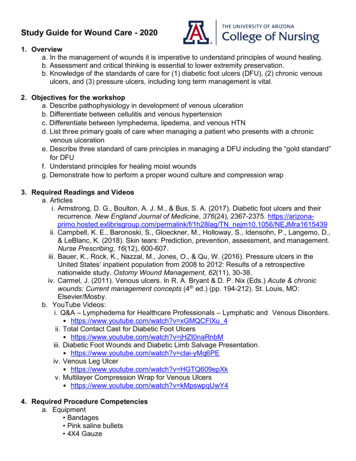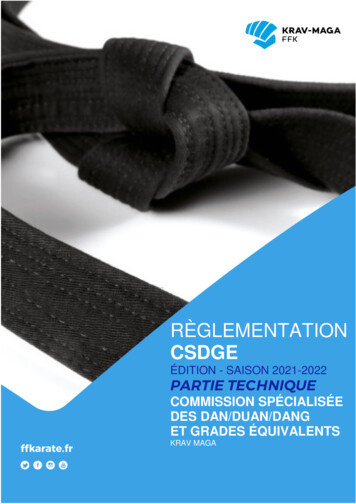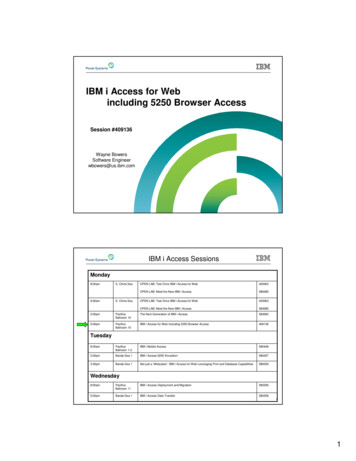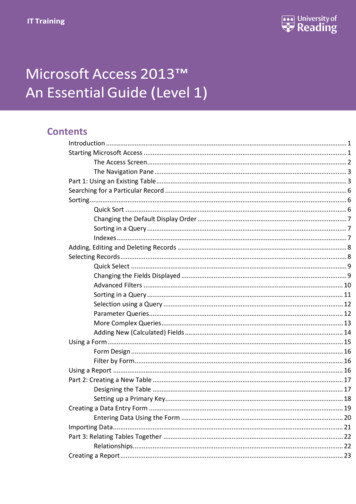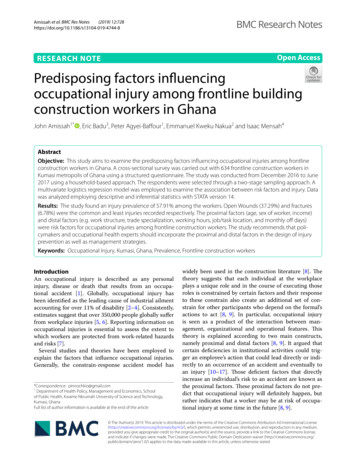
Transcription
(2019) 12:728Amissah et al. BMC Res Noteshttps://doi.org/10.1186/s13104-019-4744-8BMC Research NotesOpen AccessRESEARCH NOTEPredisposing factors influencingoccupational injury among frontline buildingconstruction workers in GhanaJohn Amissah1* , Eric Badu3, Peter Agyei‑Baffour1, Emmanuel Kweku Nakua2 and Isaac Mensah4AbstractObjective: This study aims to examine the predisposing factors influencing occupational injuries among frontlineconstruction workers in Ghana. A cross-sectional survey was carried out with 634 frontline construction workers inKumasi metropolis of Ghana using a structured questionnaire. The study was conducted from December 2016 to June2017 using a household-based approach. The respondents were selected through a two-stage sampling approach. Amultivariate logistics regression model was employed to examine the association between risk factors and injury. Datawas analyzed employing descriptive and inferential statistics with STATA version 14.Results: The study found an injury prevalence of 57.91% among the workers. Open Wounds (37.29%) and fractures(6.78%) were the common and least injuries recorded respectively. The proximal factors (age, sex of worker, income)and distal factors (e.g. work structure, trade specialization, working hours, job/task location, and monthly off days)were risk factors for occupational injuries among frontline construction workers. The study recommends that poli‑cymakers and occupational health experts should incorporate the proximal and distal factors in the design of injuryprevention as well as management strategies.Keywords: Occupational Injury, Kumasi, Ghana, Prevalence, Frontline construction workersIntroductionAn occupational injury is described as any personalinjury, disease or death that results from an occupational accident [1]. Globally, occupational injury hasbeen identified as the leading cause of industrial ailmentaccounting for over 11% of disability [2–4]. Consistently,estimates suggest that over 350,000 people globally sufferfrom workplace injuries [5, 6]. Reporting information onoccupational injuries is essential to assess the extent towhich workers are protected from work-related hazardsand risks [7].Several studies and theories have been employed toexplain the factors that influence occupational injuries.Generally, the constrain-response accident model has*Correspondence: pinnochkio@gmail.com1Department of Health Policy, Management and Economics, Schoolof Public Health, Kwame Nkrumah University of Science and Technology,Kumasi, GhanaFull list of author information is available at the end of the articlewidely been used in the construction literature [8]. Thetheory suggests that each individual at the workplaceplays a unique role and in the course of executing thoseroles is constrained by certain factors and their responseto these constrain also create an additional set of constrain for other participants who depend on the formal’sactions to act [8, 9]. In particular, occupational injuryis seen as a product of the interaction between management, organizational and operational features. Thistheory is explained according to two main constructs,namely proximal and distal factors [8, 9]. It argued thatcertain deficiencies in institutional activities could trigger an employee’s action that could lead directly or indirectly to an occurrence of an accident and eventually toan injury [10–17]. Those deficient factors that directlyincrease an individual’s risk to an accident are known asthe proximal factors. These proximal factors do not predict that occupational injury will definitely happen, butrather indicates that a worker may be at risk of occupational injury at some time in the future [8, 9]. The Author(s) 2019. This article is distributed under the terms of the Creative Commons Attribution 4.0 International License(http://creat iveco mmons .org/licen ses/by/4.0/), which permits unrestricted use, distribution, and reproduction in any medium,provided you give appropriate credit to the original author(s) and the source, provide a link to the Creative Commons license,and indicate if changes were made. The Creative Commons Public Domain Dedication waiver ) applies to the data made available in this article, unless otherwise stated.
Amissah et al. BMC Res Notes(2019) 12:728The distal factors, on the other hand, are managerial ororganizational constrain experienced by employees andtheir responses to those constraints. They are those factors that could lead, with inappropriate response/actionfrom employees indirectly to increasing the risk of accident causation as a result of the presence of the proximalfactors [18]. The distal variables highlight organizationalfactors (e.g., management, organization and operation)that makes the individual vulnerable for an occupationalinjury. The distal factors which can increase the risk ofoccupational injuries are overtime measures, productiontarget, number of working hours, type of work structure, income and task location [8–17]. Conversely, theproximal factors may include immediate individual lifestyle characteristics (e.g. alcohol consumption, smoking,adherence to safety regulation, type of work and exposure to hazards) and socio-demographic profile (e.g. age,gender, work experience) [13, 19]. More specifically, thedistal factors lead to the introduction of proximal factors,whereas the proximal factors lead to the accident causation with injury as one of the final outcomes [11, 14].In Ghana, occupational injuries have been identified among the leading causes of death. Specifically, 56out of 902 occupational accidents reported in the year2000 were from construction-related injuries [20]. Thiscalls for government policies and interventions regarding occupational injuries in the construction industry.Despite this, little is known about the predictive factorsthat contribute to the burden of occupational injuriesamong construction workers. The few empirical studiesmeasuring the prevalence and risk factors on injuries arelimited to mining [21], domestic setting [3], transportation and manufacturing industries [22, 23], with little orno attention on building construction [17, 24, 25]. Toour knowledge, no study has measured factors influencing occupational injuries among construction workers.Therefore, this paper aims to contribute to this gap byexploring the prevalence and predisposing factors influencing occupational injuries among frontline construction workers in Ghana.Main textMethodologyA cross-sectional design was employed to collect datafrom frontline building construction workers fromDecember 2016 to June 2017. The study was limited tobuilding construction workers in the Kumasi Metropolis of Ghana. Kumasi metropolis was selected due to itscosmopolitan nature, heterogeneous population and economic activities with distinct cultural enclaves making ita representation of the behaviour of building construction workers in Ghana [26]. The study recruited workersaged between 15 and 64 years who were actively engagedPage 2 of 8in construction activities for at least 12 calendar months.The workers were limited to carpenters, masons, brick/block layers, steel benders, and laborers. A sample sizeof 635 workers was estimated using Cochrane formulae[27, 28]. An assumed prevalence of 50% injuries in theconstruction industry with a precision of 5%, a designeffect of 1.5% and non-response of 10% were used to estimate the sample size. A multi-stage sampling methodwas used to select respondents. The first stage involvedselecting ten sub-metro in Kumasi metropolis. A simplerandom sampling was employed to select participantsfrom households in the communities located in eachsub-metro.Data collectionData were obtained through the administration of structured questionnaires on a face-to-face basis. The variablesused in the questionnaire were identified from previousliterature, theories, and standard injury questionnaire. Aquestionnaire template was developed and loaded ontoa smartphone with ODK (Open Data kit) [29, 30]. Theinterviews were conducted in the respondent’s preferreddialect (e.g. mostly Asante Twi) [22]. Research assistantswere trained on the use of ODK data collection software.Written informed consent was obtained from all participants enrolled in this study and identities of participantswere kept anonymous. Consent was also sought fromcaretakers and parents of minor workers below 18 yearswho were actively involved in construction work. Thequestionnaire was pre-tested at Ejisu-Juaben Municipality, to check its reliability. The weakness identified waseffected on the final questionnaire.Data analysisThe data were summarized using descriptive and inferential statistics. Multivariate Logistics regression analysiswas employed to identify the predisposing factors influencing occupational injuries. The injury was operationalized as all physical harm or damage to a person’s bodycaused by an object [1, 15]. The dependent variable wasan injury sustained by a worker and the independentvariables were individual factors such as demographic,socio-economic, job conditions, alcohol consumption,overtime and rest time. Data were analyzed using STATA14, the significant level was maintained at a P value 0.05and presented at 95% confidence interval. All monetaryvalues were converted from the Ghanaian cedis (GHS) tothe United States dollar (US ) equivalence using the prevailing exchange rate of GHS 4.2765: 1 US as publishedcentral bank of Ghana [31].
Amissah et al. BMC Res Notes(2019) 12:728ResultsThe mean age of the workers was 31.43 8.9 years,the majority were males (89.3%) and married (58.8%).About 53.3% had basic level education and 22.5% hadno formal education. The years of working experiencewere 7.57 7.4. About 44.4% worked as daily paidworkers, 17.6% as permanent and 37.9% as temporalworkers. More than half were labourers (56.2%). Fiftypercent earned a monthly income of GHS 960.0 (US 224.5) (Table 1).The prevalence and types of occupational injuriesThe injury prevalence among the frontline construction workers was 57.9%. About 37.3% experienced openwound, superficial (on surface) (15.3%), concussionand internal injuries (15.3%), dislocation and sprains(10.5%), traumatic amputation and deformity (8.5%),fractures (6.8%) and 6.5% suffered from other injuries(Table 2).Page 3 of 8Table 1 Demographic characteristicsCharacteristicsPercentage15–24 years14322.525–34 years29846.835–44 years13621.545 year579.3Age groupMean (SD)31.43 d37558.8No Formal education14322.5Basic educationa34153.3High school13721.5Tertiaryb162.51–4 years30447.75–9 years14322.510–20 years15724.621 335.2Marital statusEducational levelWorking experience (years)The predictors of occupational injuriesIn the multivariate analysis, covariates such as age, sex,type of work structure, income, trade specialization,working hours, job location and monthly off-days werestatistically significant predictors of injury (Table 3).Workers between ages 25–34 were [aOR 0.41; 95%CI 0.20, 0.80] less likely to be exposed to the riskof injury than those below 24 years. The male workers were more likely to experience injury [aOR 6.07;95% CI 2.41–15.29] compared to females. Consistently, workers who engaged permanently [aOR 3.97;95% CI. 1.93–8.17] and temporal basis [OR 2.03;95% CI. 1.25–3.31] were more likely to experience aninjury than those working on daily basis. High incomeworkers above GHS 1000 (US 233.87) [aOR 3.52;95% CI. 0.98–12.64] and GHS 1500 (US 350.83)[aOR 22.63; 95% CI. 1.60–320.51] were more likelyto be exposed to injury than low income workers.Steel Bender/Fixers were 78% protected from injury[aOR 0.22; 95% CI 0.07–0.64] compared with othertrade specialization. Similarly, Risk was reduced by 95%[aOR 0.05; 95% CI 0.02–0.15] and 84% [aOR 0.16;95% CI 0.04–0.36] for workers working between4–6 h and 7–9 h daily compared to those working above10 h. Also, workers operating from all location at theworkplace could avert injury by 71% [aOR 0.29; 95%CI 0.85–1.01] compared to working on rooftops andfrom height. Workers who were entitled to off-days were96% protected from the possibility of experiencing injury[aOR 0.96; 95% CI 0.04–0.24] compared to thosewithout off-days.Frequency (n 634)Mean SD7.57 (7.40)Work structureDaily paid worker (by day work)28344.4Temporal workers24237.9Permanent worker11117.6360–499 [84.2–116.7]192.9500–999 [116.9–233.6]38961.11000–1499 [233.8–350.5]20432.01500 [350.8]253.9Monthly income in GHS [US ]Average income in GHS (SD)954.86 [223.3] 311.89 [72.9]Median [US ]960 [224.5]Average wage [US ] SD perArtisanMedian [US ] wage per ArtisanMasonLabourerCarpenterSteel bender60 [14.0] 22.8 [5.3]33.70 [7.9] 6.3 [1.5]52.86 [12.4] 12.9 [3.0]50 [11.7]30 [7.0]60 [14.0]46.31 [10.8] 10.8 [2.5]50 eel bender335.1Average wage per artisans [US ] SD40.65 [9.5] 13.0 [3.0]Trade specializationGHS 4.2765: US 1aBasic education: nine-year training from primary one to completion juniorhigh school and Middle SchoolbTertiary education: includes University and Polytechnics
Amissah et al. BMC Res Notes(2019) 12:728Page 4 of 8Table 2 Body regions, injury types and frequenciesVariableFrequencyPercentageInjury experience in last 12 monthsYes35557.9No25842.0Type of injuryFracture246.713237.3Dislocation and sprains3710.5Superficial (on surface) injury5415.3Concussion and internal injury5415.3Traumatic amputation and deformity308.5Other specific injuriesa236.5Open woundaOther specific Injuries: All those including effects of heat, electric shocks,physical and psychological abuses, multiple injuries without specific descriptionDiscussionThe study adds to the existing literature, as the findingsare discussed using the constraint-response accidentmodel. The constructs used to organize the discussionare (1) prevalence and type of occupational injuries, (2)proximal factors predicting occupational injuries and (3)distal factors influencing occupational injuries.The prevalence and type of injuries sustainedThe study showed that more than half, (57.9%) of construction workers had experienced occupational injuries.The prevalence appears to be higher when compared toprevious estimates elsewhere [32]. Even though there areno nationally representative data on the extent of injuriessustained by construction workers, the current prevalence is about 9.3 times higher than previous reports bythe labour commission, which estimated that 6.2% ofoccupational accidents lead to deaths in construction[20]. Of relevance, the present finding demonstrates anincreasing burden of injuries among workers. This confirms previous literature in Ghana and Europe whichreported the industry to be injury-prone [17, 24, 25].Specifically, injuries sustained by the workers were openwounds, superficial (on surface) and concussion andinternal injury. These injuries are similar to the categories of injuries reported to be sustained by constructionworkers globally [33–38]. The study recommends thatpolicymakers and occupational health experts shoulddevelop preventive and management strategies thatincorporate specific injury part sustained. Also, futureresearch should employ interventional studies to measure the effectiveness of preventive strategies for managing occupational injuries among construction workers.This could inform regulatory authorities to improve theirhealth education and promotion campaigns.Proximal factors predicting of occupational injuriesThe proximal factors influencing occupational injurieshighlight the immediate individual lifestyle characteristics (e.g. alcohol consumption, smoking, adherenceto safety regulation, type of work and exposure to hazards) and socio-demographic profile. These factors had arelationship with occupational injuries. In this study, thesocio-demographic profile such as age, sex, and incomesignificantly predicted occupational injuries among construction workers. In particular, males were at high riskof being injured compared with females. In Ghana, thesocio-cultural characteristics restrict the constructionactivities to males. This is due to the rigorous and hazardous nature of the construction industry [39]. Therefore, female workers are recommended to be placed inroles with limited risk in the industry. In addition, theincome level of construction workers is a significantrisk factor for occupation injury. Tasks with a high riskof injury usually require an expert to execute. However,in performing such duties, the worker’s exposure to suchrisk becomes higher which may eventually translate toinjuries compared to other workers assigned to simpletasks. In Ghana, construction workers with this technical expertise are usually short in supply and also demandrelatively higher wages than those doing menial andcausal works. This possibly explains why workers in thiscategory were at higher risk of occupational injury.In addition, the risk of occupational injury increasedwith older workers compared to the youthful age group(economic active population). Older workers are susceptible to severe injury than younger ones [32, 40–42].Aging process involves a series of physiological changesto the body that can make construction tasks very difficult for old people. The strength and ability required ofa person to carry out physically demanding tasks effectively reduce as one age. Decrease cardiac output mayaffect a worker’s performance on physical demandingactivity and increase his susceptibility to injury [43].The study recommends stakeholders to consider theage profile, gender identity and socioeconomic statusof construction workers when designing preventive andmanagement strategies for injuries. In particular, futureresearch should use a longitudinal approach to reporta national representative data on occupational injuriesamong frontline construction workers. This can informgovernment policy and interventions. Further, researchers interested in occupational health-related issuesshould explore the reasons for the increased occupationalinjuries among different age, gender, and socio-economicwealth quintiles. For instance, future research shouldused a qualitative methods to explore the subjectiveexperiences of frontline construction workers in managing occupational injuries.
Amissah et al. BMC Res Notes(2019) 12:728Page 5 of 8Table 3 Univariate and multivariate analysis of risk factors for occupational injuries among frontline buildingconstruction workers in Ghana, 2016/17VariablesUnivariate modelCrude odd ratio (OR; 95%CI)Multivariate modelP-valueAdjusted odd ratio (aOR;95% CI)P-valueAge group15–24 years (ref )1.00–1.00–25–34 years0.77 (0.51, 1.16)0.210.41 (0.20, 0.80)0.00935–44 years1.04 (0.64, 1.69)0.880.53 (0.19, 1.44)0.2145 year2.48 (1.20, 5.13)0.010.78 (0.23, 2.63)0.68Sex of workerFemale (ref )1.00–1.00–Male5.51 (2.90, 10.45)0.0016.07 (2.41, 15.29)0.001Marital statusSingle (ref )1.00–––Married1.25 (0.91, 1.73)0.18––Educational levelNo formal education ref1.00–––Basic education0.65 (0.42, 0.99)0.04––High school0.61 (0.36, 1.03)0.06––Tertiary0.75 (0.27, 2.14)0.60––Working experience (years)1–4 years0.23 (0.09, 0.56)0.001––5–9 years0.41 (0.16, 1.07)0.068––10–20 years0.34 (0.13, 0.87)0.02––21 (Ref )1.00–––Income360–499 [84.2–116.7] (ref )1–1–500–999 [116.9–233.6]1.28 (0.50, 3.24)0.6101.37 (0.38, 4.92)0.621000–1499 [233.8–350.5]3.79 (1.45, 9.92)0.0073.52 (0.98, 12.64)0.051500 [350.8]30.25 (3.35, 273)0.00222.63 (1.60, 320.51)0.02Work structureDaily paid worker (by day work) (Ref )1.00–1.00–Temporal contract workers1.24 (0.87, 1.76)0.2312.03 (1.25, 3.31)0.004Permanent worker4.60 (2.68, 7.89)0.0013.97 (1.93, 8.17)0.001Trade specializationMason (ref )1–1–Labourer1.85 (1.27, 2.69)0.0010.77 (0.37, 1.57)0.46Carpenter0.46 (0.24, 0.89)0.021.09 (0.40, 3.00)0.85Steel bender1.33 (0.61, 2.89)0.470.22 (0.07, 0.64)0.01Working hours4–6 h0.12 (0.05, 0.25)0.0010.05 (0.02, 0.15)0.0017–9 h0.23 (0.09, 0.63)0.0040.16 (0.04, 0.36)0.00910 h (ref )1–1–Safety instructionNo1.27 (0.82, 1.99)0.27––Yes (ref )1–––Currently smokingNever smoked (ref )1.00–––Currently smokes2.41 (0.78, 7.49)0.13––
Amissah et al. BMC Res Notes(2019) 12:728Page 6 of 8Table 3 (continued)VariablesUnivariate modelMultivariate modelCrude odd ratio (OR; 95%CI)P-valueAdjusted odd ratio (aOR;95% CI)P-valueAlcohol consumptionDo not consume (ref )1.00–––Consume1.69 (1.13, 2.55)0.010––0.61 (0.16, 2.31)0.46Job/task locationRooftop1–Lower floor/ground0.22 (0.09, 0.48)0.001–Height from ground0.19 (0.08, 0.45)0.0010.82 (0.21, 3.26)0.78All location0.18 (0.80, 0.38)0.0010.29 (0.85, 1.01)0.05Daily production targetNo1–––Yes0.75 (0.53, 1.05)0.100––Monthly off daysNo1–––Yes0.20 (0.11, 0.38)0.0010.96 (0.04, 0.24)0.001Monthly working days20 days1–––24 days0.86 (0.54, 1.34)0.496––26 days0.48 (0.15, 1.49)0.203––30 days2.55 (0.51, 12.68)0.252––Significant values are in italicsDistal factors influencing occupational injuriesThe distal factors predicting occupational injuriesdescribe the organizational and work-related characteristics associated with the injuries. Specifically, the studyshowed that daily production targets, job location, workstructure, trade specialization and off working days influence the risk of occupational injuries among frontlinebuilding construction workers. Working continuouslywithout breaks, off-days and vacations predict the risk ofinjury among construction workers. Our study showedthat a worker who enjoys off-days in a month is 96% protected from injury occurrence compared to those working every day throughout the month. Once a workerengages in continuous work without vacations, holidaysand off-days, there is the possibility of fatigue setting in,and when this happens it affects performance and productivity [19]. Therefore, job schedules that offer workerslimited opportunities for breaks, off-days, and vacationsshould be discouraged by managers of the industry.Working on a permanent basis or as a temporal workermakes a worker more susceptibility to injuries more compared to working daily paid workers. Daily paid workers in the Ghanaian construction industry are normallyengaged for relatively short periods, they visit job sitesas and when they think they need to work. Such workers are mostly hired to carry out simple task which doesnot require any special expertise. Permanent workers arelikely to experience the cumulative effects of the exposures on their health, unlike the daily paid workers. Finding from our study revealed that, workers operating fromall locations and lower grounds were 71% and 39% protected from the possible risk of experiencing injury compared to working from a rooftop and elevated ground.This suggests that the chance of slipping from heightand its impact on the individual is greater. This corroborates with previous findings from the US, UK, and SouthAfrica which indicated that working from a height andelevation above the ground is the most cited cause of fallrelated injuries [42, 44–46]. The study recommends thatpolicymakers and occupational health experts shouldincorporate the identified distal factors in the planningand designing of construction projects as part of theirinjury prevention intervention as well as managementstrategies. We recommended that further research designwith rigorous methods such as a cohort study should beemployed to examine the causal relationship betweenthe distal and proximate variables over time. Also, aninterventional study is recommended for assessment ofthe effectiveness of organizational strategies that aim toimprove the distal factors facilitating occupational injuries among frontline construction workers.
Amissah et al. BMC Res Notes(2019) 12:728LimitationThe study has limitations in terms of the scope, the target population, data-collection instrument, sampling,and possible recall bias. The study was limited to onlyconstruction workers in the Kumasi metropolis without incorporating the perspectives of regulatory bodies and workers in other parts of the country. Also, theinstrument used to collect the data was a self-developedquestionnaire based on previous literature, theory, andstandard injury questionnaire. The study did not adoptany existing validated instrument. Nevertheless, severalscientific scrutinies such as pre-testing of tools, randomsampling, development of tools using previous literature,informed consent processes, statistical analysis, and discussion of findings in the context of relevant literaturewere employed to minimize biases.AbbreviationsAOR: adjusted odds ratio; CI: confident interval; GHS: Ghanaian cedis; ODK:Open Data Kit; OR: odds ratio; US : United States dollar.AcknowledgementsNot applicable.Authors’ contributionsJA, PAB, EB: conceptualized and designed the study, carried out statisticalanalysis, write up and preparation of the first draft. EB, EKN, IM: Assisted in thewrite-up and review of the manuscript. All authors read and approved thefinal manuscriptFundingThere was no funding support for this study.Availability of data and materialsThe datasets used and analyzed for this study are in the custody of the cor‑responding author and will be made available on a reasonable request.Ethics approval and consent to participateThe study was reviewed and approved by the Committee on Human ResearchPublication and Ethics of the School of Medical Sciences, Kwame NkrumahUniversity of Science & Technology, Kumasi. Written informed consentwas obtained from all participants enrolled in this study and identities ofparticipants were kept anonymous. Parental consent was sought from minors(below 18 years) who were engaged in an active construction job.Consent for publicationNot applicable.Competing interestsThe authors declare that they have no competing interests.Author details1Department of Health Policy, Management and Economics, School of PublicHealth, Kwame Nkrumah University of Science and Technology, Kumasi,Ghana. 2 Department of Epidemiology and Biostatics, School of Public Health,Kwame Nkrumah University of Science and Technology, Kumasi, Ghana.3School of Nursing and Midwifery, University of Newcastle, Callaghan, Aus‑tralia. 4 Isaac Mensah, Department of Special Education, University of Educa‑tion, Winneaba, Ghana.Received: 20 August 2019 Accepted: 17 October 2019Page 7 of 8References1. Stanaway JD, Afshin A, Gakidou E, et al. Global, regional, and nationalcomparative risk assessment of 84 behavioural, environmental andoccupational, and metabolic risks or clusters of risks for 195 countriesand territories, 1990–2017: a systematic analysis for the Global Burden ofDisease Study 2017. Lancet. 2018;392:1923–94.2. Collaborators GBD. Global, regional and national levels of age-specificmortality and 240 causes of death, 1990–2013: a systematic analysis forthe Global Burden of Disease Study 2013. Lancet. 2015;385:1990–2013.3. Gyedu A, Nakua EK, Otupiri E, Mock C, Donkor P, Ebel B (2014) Incidence,characteristics and risk factors for household and neighbourhood injuryamong young children in semiurban Ghana: a population-based house‑hold survey. Inj Prev injuryprev-2013-040950.4. Institute for Health Metrics and Evaluation (2016) Institute for HealthMetrics and Evaluation: Ghana.5. Hämäläinen P, Takala J, Saarela KL. Global estimates of occupationalaccidents. Saf Sci. 2006;44:137–56.6. Takala J, Hämäläinen P, Saarela KL, Yun LY, Manickam K, Jin TW, Heng P,Tjong C, Kheng LG, Lim S. Global estimates of the burden of injury andillness at work in 2012. J Occup Environ Hyg. 2014;11:326–37.7. International Labour Organization. Statistics of occupational injuries.1998.8. Suraji A, Duff AR, Peckitt SJ. Development of causal model of constructionaccident causation. J Constr Eng Manag. 2002. https .9. Haslam RA, Hide SA, Gibb AGF, Gyi DE, Atkinson S, Pavitt TC, Duff R, SurajiA. Causal factors in construction accidents. Exec: Health Saf; 2003. p. 156.10. Gibb A, Hide S, Haslam R, Hastings S, Suraji A, Duff AR, Abdelhamid TS,Everett JG. Identifying root causes of construction accidents. J Constr EngManag. 2001;127:348–9.11. Hamid ARA, Majid MZA, Singh B. Causes of accidents at constructionsites. Malays J Civ Eng. 2008;20:242–59.12. Hinze J, Pedersen C, Fredley J. Identifying root causes of constructioninjuries. J Constr Eng Manag. 1998;124:67–71.13. Lipscomb HJ, Glazner JE, Bondy J, Guarini K, Lezotte D. Injuries from slipsand trips in construction. Appl Ergon. 2006;37:267–74.14. Toole TM. Construction site safety roles. J Constr Eng Manag.2002;128:203–10.15. Amissah J, Agyei-Baffour P, Badu E, Agyeman JK, Badu ED. The cost ofmanaging occupational injuries among frontline construction workers inGhana. Value Heal Reg Issues. 2019;19:104–11.16. Haagsma JA, Graetz N, Bolliger I, et al. The global burden of injury: inci‑dence, mortality, disability-adjusted life years and time trends from theGlobal Burden of Disease study 2013. Inj Prev. 2016;22:3–18.17. Hide S, Atkinson S, Pavitt TC, Haslam R, Gibb AGF, Gyi DE. Causal factors inconstruction accidents. 2003.18. Suraji A, Duff AR, Peckitt SJ. Development of causal model of constructionaccident causation. J Constr Eng Manag. 2001;127:337–44.19. Lombardi DA, Jin K, Courtney TK, Arlinghaus A, Folkard S, Liang Y, PerryMJ. The effects of rest breaks, work shift start time, and sleep on the onsetof severe injury among workers in the People’s Republic of China. Scand JWork Environ Health. 2014;1:146–55.20. Ghana Labour Department. Annual Labour report. 2000; 114:286–293.21. Basu N, Clarke E, Green A, Calys-Tagoe B, Chan L, Dzodzomenyo M, Fobil J,Long RN, Neitzel RL, Obiri S. Integrated assessment of artisanal and smallscale gold mining in Ghana—Part 1: human health review. Int J EnvironRes Public Health. 2015;12:5143–76.22. Afukaar FK, Antwi P, Ofosu-Amaah S. Pattern of road traffic inj
Amissah et al. BMC Res Notes P28 e distal factors,he ot,e managerial or organizational constrain experienced by employees and their responses to those constraints.y are those fac-tors that could le,ith inappropriate respons/tion from employees indirectly to increasing the risk of acci-

